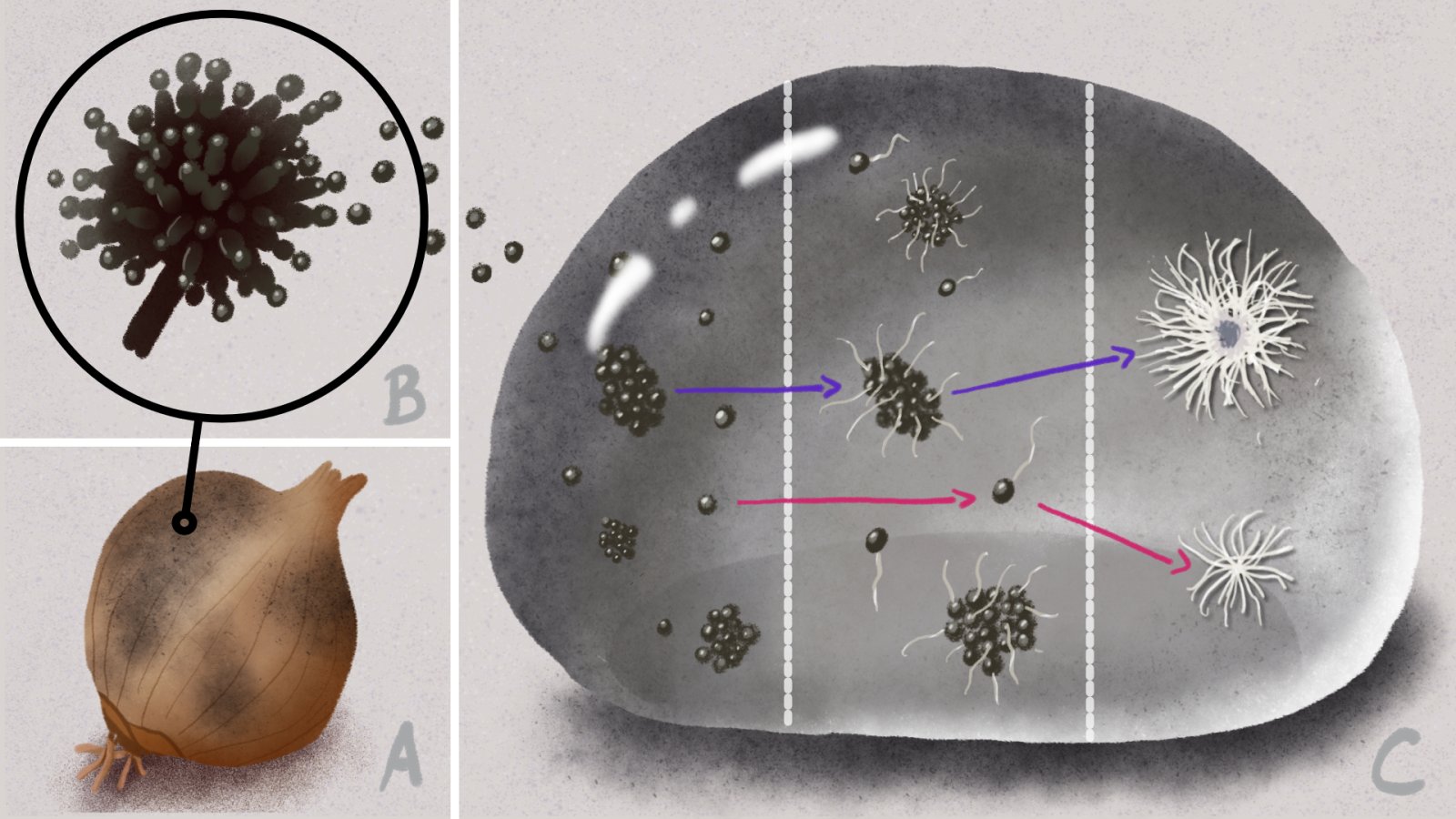Diversity in colony size makes fungus more effective and stress-resistant
Possible implications for the industrial production of protein mixtures
By growing in colonies of different sizes, the fungus Aspergillus niger is more effective in breaking down cellulose and more resistant to stress. Microbiologists from Utrecht University report these findings in an article in the scientific journal mBio. Aspergillus niger is widely used for the production of protein mixtures, which play an important role in the manufacturing of, for instance, biofuels or bioplastics. The insight therefore has potential implications for industry. The diversity in colony size might also play a role in the life of the fungus in nature.
You might have come across it in your kitchen cupboard: a decaying onion, covered in black spores. Most likely, the onion was the victim of Aspergillus niger, one of the most common fungi in the world. Aspergillus niger lives mostly on dead organic material, especially dead plants.
The fungus secretes a wide variety of substances, including acids and proteins, that enable it to break down and absorb the material it lives on. Because the fungus is so effective at making and excreting substances, it is widely used to industrially manufacture, amongst other things, enzymes. Enzymes are proteins involved in chemical reactions. For example, the fungus secretes glucoamylase, an enzyme used to produce glucose syrup, which is added to food products like candy and beer.

Colonies of different sizes
To reach new food sources, Aspergilles niger produces spores that are spread via the air, insects or water droplets. When such a spore germinates, fungal threads start to grow from it. On solid surfaces, these threads can grow into colonies several centimeters in size. But when the fungus is grown in a liquid, the colonies remain a lot smaller. The smallest of these simply consist of a small cluster of fungal threads. The larger colonies are somewhat more complex, having a central area and an outer ring.

Microbiologist Han Wösten explains how the different-sized colonies form in a liquid. Wösten: "We noticed that part of the spores in a liquid stick together, while the rest of the spores do not. The spores that stick together grow into the larger colonies. We then began to wonder why only some of the spores clump together. Is it just coincidence or might there be a reason behind it?"
Higher activity
In an attempt to answer this question, the researchers decided to grow the fungus into colonies of different sizes. They managed to do so by allowing the fungus to grow inside capsules for longer or shorter periods of time. The researchers then analyzed how much and which enzymes the different-sized colonies produced. Wösten: "Surprisingly, the large colonies secreted smaller amounts of enzymes than the small ones, and also fewer different enzymes. But the large ones did produce certain enzymes that the small ones did not secrete."
Next, the researchers combined the enzymes from the large and small colonies. They looked at how effective the mixture was at breaking down cellulose, a compound found in the cell walls of plants. Doing so, they found that the combined enzyme mixture broke down cellulose faster than the enzymes from only small or only large colonies. Similarly, when the researchers combined large and small colonies in a liquid, they observed that the cellulose was broken down faster than in a liquid containing colonies of one particular size.
Together, the colonies of different sizes are stronger. The small ones feed the big ones and the big ones increase the chances of survival.
More resistant to heat
The microbiologists also exposed the colonies of different sizes to high temperatures. They noticed that the larger colonies were more resistant to heat than the small ones. Wösten: "The outer ring of the larger colonies protects the inner part. This means that together, the colonies of different sizes are stronger. The small ones feed the big ones and the big ones increase the chances of survival."
Bioethanol
According to Wösten, in industry it is often found undesirable that Aspergillus niger grows in colonies of different sizes. But in some cases, colony size diversity can actually be advantageous. Wösten: "If you only want one enzyme, then you can easily aim for just small colonies. After all, those are highly productive. But if you want to break down mass, as in the production of bioethanol, then it is advantageous to have that variation, because it makes the breakdown more efficient."
Insect legs and aerosols
It is not yet clear whether the newly discovered mechanisms also play a role in nature. But according to Wösten, it is quite possible. Wösten: "We know that multiple spores can be dispersed simultaneously in a droplet via aerosols. We also know that clumps of spores are spread via insect legs. Those spores can end up in a drop of water, where the whole story can take place. But we have not demonstrated that yet. It is not so easy to find such an initial stage in nature, a drop of water that happens to contain some Aspergillus niger spores."
Publication
Jun Lyu, Martin Tegelaar, Harm Post, Juan Moran Torres, Costanza Torchia, A. F. Maarten Altelaar, Robert-Jan Bleichrodt, Hans de Cock, Luis G. Lugones, Han A. B. Wösten
mBio, 11 January 2023, DOI: https://doi.org/10.1128/mbio.00870-22

